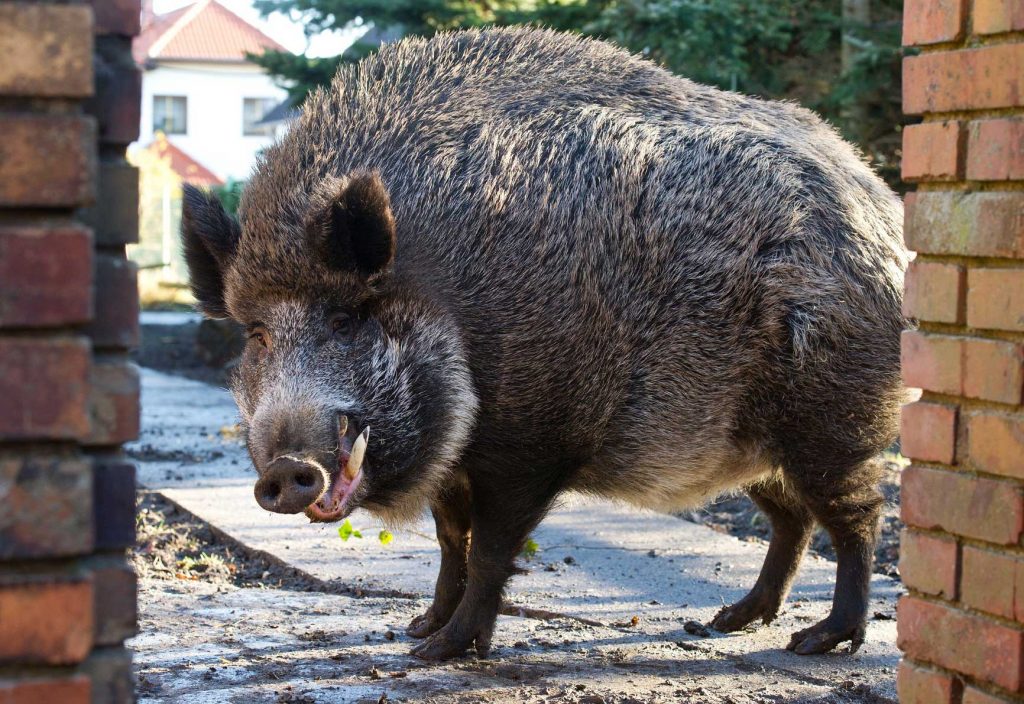Our friend Vera gave us a good amount of wild boar meat for a Christmas present. I must say, there’s a first time for everything! Her father-in-law is an avid boar hunter and always has a freezer full. I plan to make it for our New Years Eve dinner. She even brought a good bundle of herbs to cook it with, juniper, sage, rosemary and thyme. I will stew it until it falls off the bone and make it into a ragu or I will just make a stew. Mm mmmm good! I will report back. I plan to cook it on New Years Eve.
We happened on a boar hunt last week. There were probably fifty cars along the mountain road and hunters with guns everywhere. A fire burned to ward of the cold. Dogs were in cages in the backs of trucks. It was around 10 AM and the hunt was already finished.
After a hunt. (They can kill any number of boar. There is no limit. It is not unheard of to kill 100 at a time!)

Not knowing much about it I looked it up. Also I borrowed the pictures herein. Here are some facts I learned. There are about 150,000 wild boar in Tuscany and Umbria. A female boar has two litters a year with 3 to 13 piglets in each. Even though 30,000 boar are killed a year it is impossible to keep up.
70% of the hunters are from Sardinia, Tuscany and Umbria. And Italy being Italy, each region claims its boar is superior to another region’s. Tuscans will tell you that the fiercest boar lives in the Maremma. Tuscans will also tell you their boar tastes best because it feasts on the chestnuts that grow in the area’s forests. Sardinians will boast that theirs, being an island boar, is closest to the animals the Greeks first found on Capri and thus is the true Italian boar. They claim it’s tastiest because it feeds on the acorns that fall from the island’s groves of oaks. Umbrians contend that their boar is the most refined and the best tasting, for a reason that is hard to argue with: The countryside is rich in pungent black truffles, a favorite food of the boar’s throughout the winter.
Cinghiale hunts called cacciarella (“small hunt”) are highly choreographed and organized activities. The season begins 1 November and ends 31 January. Squadre (teams) for each territory need official registration, a boss and at least 50 members, all of whom must take a hunting course. They must re-register annually and renew their firearm licences every six years. If on the day of the hunt less than 20 hunters show up, the hunt cannot officially proceed.
Hunting days are specified by law with three days per week assigned to each locality during the season. The teams work year-round training their dogs, who have a high possibility of being killed during the hunt. And not in a pretty way.
On the day of the hunt, the team divides into canai (the men with the dogs), postaioli (the men in position with rifles) and tracciatori (the trackers).
A typical start to the hunt involves 20 tracciatori searching for fresh traces. Once done, they go back to the base to confer with the capocaccia (boss of the hunt), who decides on the best zone. The 30-50 postaioli form a horseshoe close to the fresh tracks, keep still and wait.
Next the 10 canai come along, each with seven or eight trained dogs. At the capocaccia’s command, they release their dogs in hopes of flushing out a cinghiale and directing it towards the horseshoe-shaped trap of the gun-wielding postaioli.
Hunters may shoot only straight ahead, so even if a hunter sees the boar first, but it is not directly in front of him, he must wait for his fellow postaiolo to shoot so as not to endanger the lives of others.
Once the boar has been shot, it is taken to the hunting headquarters, weighed, identified by its teeth for age, and written in the records; then it is hung and bled, skinned and left for two days at 0°C to frollare-develop flavor and relax the flesh. Then the team divides the boar, with each person on the hunt getting a piece.
In Italy no part of the cinghiale goes to waste. The meat, of course, gets eaten, either as hard salami, softer salsiccia, or ham, while the best boars are often cured and aged as that great delicacy, prosciutto di cinghiale. The white tusks are occasionally carved into buttons and knife handles or mounted in gold and worn by women as pendants. The thick hair is used for hairbrushes, toothbrushes, dartboards, and the little sprigs you see on traditional Tyrolean hats.
I read this account of one hunt on an estate in Tuscany. “It is tradition in Italy that there be a feast provided by the lord or lady of the estate after the hunt. We were not disappointed. Roast pork, Tuscan steak, pappardelle, spaghetti, sausages, cured meats, hunks of cheese, countless bottles of wine, and more were spread out on a giant U-shaped table set for 40. The hunters traded tales from the morning. We finished lunch a couple of hours later and walked outside to have coffee.”


